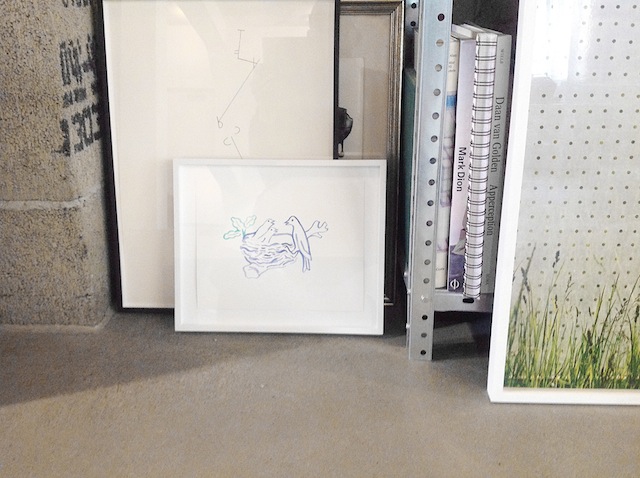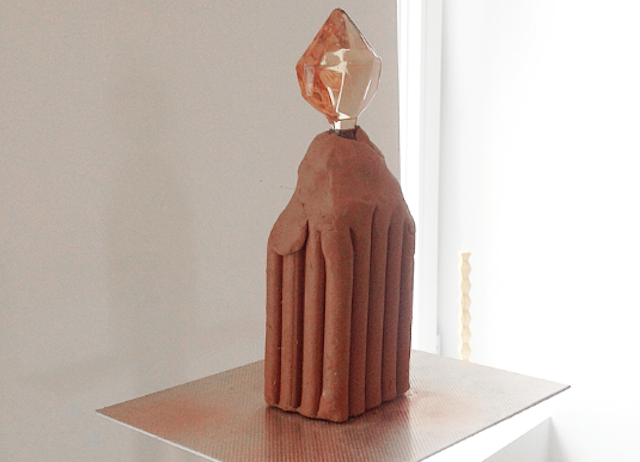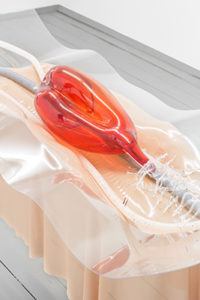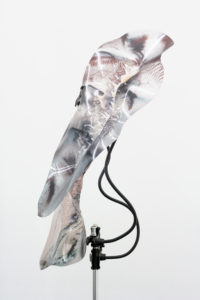I wondered at first whether it wasn’t one giant art world joke. The final show of Exile’s Berlin manifestation required that guests RSVP by email, print their confirmation, and face the bouncer at the gates. The idea of a printed RSVP was the first thing that irked me. In these hyper-digital times it seems impertinent to require a hardcopy of anything.
In the courtyard of the unknown Kreuzberg apartment building where we gathered, there were people milling about outside of the pop-up bar. It occurred to me – and not just for a second – that maybe we’d been duped. Maybe the so-called “imaginary” collection of Mr. Kempinski was just that: imaginary. I was already skeptical of a show with 60 participating artists and it all seemed to make perfect sense that they would give such a mysterious aura to the event, only to enhance the spectacle when we all showed up for nothing.

Happily, my suspicion was wrong. An elevator took us up to the top floor of the apartment complex where we were ushered into the main ‘gallery’ space. It was something like a showroom for luxurious condo living – a kitchen, bed, couch, and coffee table were all in place but in an eerily artificial way. More like the set design of what an apartment should look like.
In the entrance hallway, on the balcony, on pretty much every surface, there were works of art. With the exception of a handful of videos, the show was remarkably paper and canvas-heavy.
Not being able to fully absorb all the works was invigorating. It made it easier to take in the whole atmosphere. After feverishly trying to match names with pieces I settled down in a corner and looked at the room as a whole. Paintings, sculptures, and photographs were leaning against walls, some propped on the floor or on windows. The accompanying exhibition write-up, divided the space into 14 sections – kitchen, balcony, living area, south wall, etc. – but the titles of works were omitted. Whether it was an intentional commentary on the cult of the Artist or not, this unease at identifying pieces was a welcome change from the usual format.

Further blurring the easy reception of the works, some of the artists who were well-known to me, like Hanne Lippard and Martin Kohout, presented uncharacteristic pieces in the show (alongside some of their more well-known works). Kohout showed ‘hot glue drawings on mesh’ and Lippard a small watercolour drawing of birds. The show also featured one of Lippard’s characteristic voice-driven videos and will later present a one year anniversary celebration by Kohout on the evening of June 13, to commemorate his Gotthard Tunnel Run in Switzerland during LISTE Basel last year. Polish artist Katharina Marszewski exhibited one of her collages under plexi glass, which tied seamlessly with the aesthetic of the show as a whole. Marszewski’s minimalist works reflect the kind of subdued yet dexterous pieces that would make up a private collection (whether fictional or not) on view in a home setting.

There were few loud works in the show, pieces that took all the attention. But the playful sculpture by Aggtelek was eye-catching in this cluttered context. It stood on the floor across the room from a detailed costume by Nadja Abt, the two seeming to respond to each other in their performative stillness.
The ‘collection’ presented in this show is defined as fluctuant and the curators – Exile Berlin’s Christian Siekmeier and New York-based curator Billy Miller – ask viewers to reflect upon the relationship between art and collecting. Though the exhibition was far-reaching in terms of content, the curators managed to ground the show with a central display table presenting books of published works by many of the artists. The ‘library’ provided a space amidst the works to make sense of their authorship. But ultimately, I found the relative anonymity of the exhibition refreshing. **
















